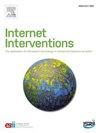Evaluating visual feedback of experience sampling data for mental health practitioners
IF 4.1
2区 医学
Q1 HEALTH CARE SCIENCES & SERVICES
Internet Interventions-The Application of Information Technology in Mental and Behavioural Health
Pub Date : 2025-09-17
DOI:10.1016/j.invent.2025.100873
引用次数: 0
Abstract
Background
The Experience Sampling Method (ESM) allows to capture and quantify people's daily experiences, thoughts, and behaviors in real-world contexts. While ESM holds great promise for informing case conceptualization and improving therapeutic targeting in mental health care, visualizations of self-reported ESM data remain largely tailored to researchers and are often not easy to interpret for mental health practitioners. To what extent such visualizations can assist practitioners within their context of mental health care remains still unclear.
Objective
This study investigates the effect of including uncertainty information in visualizations of ESM feedback on practitioners' decision-making processes.
Methods
We recruited 40 Belgian mental health practitioners and students in their last year of psychology or educational science studies to take part in an experiment that assessed their proficiency in interpreting ESM feedback based on reality-inspired clinical cases. Three variables (i.e., interactive hover function, error bars, and textual descriptions about effect size and confidence interval) were manipulated in a balanced factorial design to determine their effects on correct data interpretation.
Results
The results indicate that providing textual descriptions about effect size and confidence intervals increased practitioners' confidence levels and accuracies compared to error bars alone. Furthermore, practitioners want to integrate ESM feedback into treatment. When ESM feedback was associated with low confidence, they preferred to further explore the clinical case. In contrast, when ESM feedback was associated with high confidence, they opted for more action-oriented interventions.
Conclusion
These findings underscore the importance of including textual descriptions in graphical visualizations as they help to improve practitioners' decision-making processes in mental health care.
心理健康从业人员经验抽样数据视觉反馈评价
经验抽样法(ESM)可以捕捉和量化人们在现实世界中的日常经历、想法和行为。虽然ESM在告知病例概念化和改善精神卫生保健的治疗目标方面有很大的希望,但自我报告的ESM数据的可视化仍然主要是为研究人员量身定制的,并且通常不容易为精神卫生从业人员解释。在多大程度上,这种可视化可以帮助从业者在他们的精神卫生保健的背景下,仍然不清楚。目的探讨在ESM反馈可视化中加入不确定性信息对从业人员决策过程的影响。方法我们招募了40名比利时心理健康从业人员和心理学或教育科学专业最后一年的学生参加一项实验,评估他们根据现实启发的临床案例解释ESM反馈的熟练程度。在平衡因子设计中,对三个变量(即交互悬停函数、误差条和关于效应大小和置信区间的文本描述)进行处理,以确定它们对正确数据解释的影响。结果结果表明,与单独提供误差条相比,提供有关效应大小和置信区间的文字描述提高了从业人员的置信水平和准确性。此外,从业者希望将ESM反馈整合到治疗中。当ESM反馈与低信心相关时,他们倾向于进一步探索临床病例。相比之下,当ESM反馈与高度自信相关时,他们选择了更多的行动导向干预措施。结论这些发现强调了在图形可视化中包含文本描述的重要性,因为它们有助于改善从业者在精神卫生保健中的决策过程。
本文章由计算机程序翻译,如有差异,请以英文原文为准。
求助全文
约1分钟内获得全文
求助全文
来源期刊

Internet Interventions-The Application of Information Technology in Mental and Behavioural Health
Medicine-Health Informatics
CiteScore
6.50
自引率
9.30%
发文量
94
审稿时长
6 weeks
期刊介绍:
Official Journal of the European Society for Research on Internet Interventions (ESRII) and the International Society for Research on Internet Interventions (ISRII).
The aim of Internet Interventions is to publish scientific, peer-reviewed, high-impact research on Internet interventions and related areas.
Internet Interventions welcomes papers on the following subjects:
• Intervention studies targeting the promotion of mental health and featuring the Internet and/or technologies using the Internet as an underlying technology, e.g. computers, smartphone devices, tablets, sensors
• Implementation and dissemination of Internet interventions
• Integration of Internet interventions into existing systems of care
• Descriptions of development and deployment infrastructures
• Internet intervention methodology and theory papers
• Internet-based epidemiology
• Descriptions of new Internet-based technologies and experiments with clinical applications
• Economics of internet interventions (cost-effectiveness)
• Health care policy and Internet interventions
• The role of culture in Internet intervention
• Internet psychometrics
• Ethical issues pertaining to Internet interventions and measurements
• Human-computer interaction and usability research with clinical implications
• Systematic reviews and meta-analysis on Internet interventions
 求助内容:
求助内容: 应助结果提醒方式:
应助结果提醒方式:


